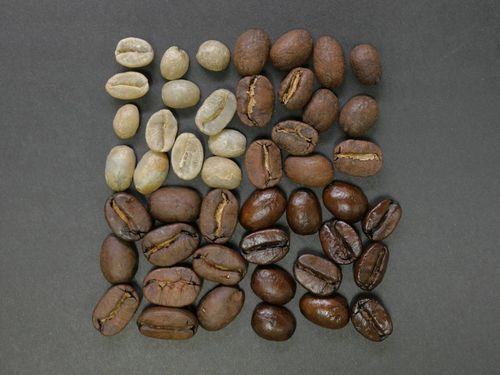For many, coffee is a daily ritual, a cup to kickstart the day or to beat the afternoon blues. The simple joy of enjoying it can bring friends and family closer. Yet, have you ever thought about what makes it so great? What’s behind crafting a truly quality cup of espresso? How many coffee types are there? Let’s unravel it all on this caffeine-filled journey with a special focus on the rich and diverse offerings from Italy. And also, because we know you’ve come to us looking for the best coffee places in Italy and precisely Rome, we’ve got just what you need!
Related: Rome’s Most Exquisite Pasta Dishes
The best coffee starts with…
Great coffee starts with something as basic as fresh, quality beans. The creation of a well-rounded flavor requires to skillfully blend several types of beans. Thus, as you can see the taste of the final coffee relies on many factors, and its quality is a bit subjective because consumers have their own likes. Yet, there are certain traits that experts agree make a really good cup of coffee:
- Bean quality directly shapes the final product. Hence, tracing the origins is crucial to ensure its quality. It lets us follow the path of coffee beans from where they are grown to your cup, giving special focus to those that are ethically and sustainably handled. Below, you’ll find some of the factors that define quality beans:
- Origin: the flavor of coffee varies based on where it’s grown, and each region yields beans with unique traits.
- Altitude: coffee grown at higher altitudes often has more nuanced flavors and brighter acidity, and that’s desirable.
- Variety: Arabica and Robusta are the main types. The first is considered superior for its smoother, more refined taste.

Image by Freepik
Related: Rome Off the Beaten Path On a Weekend
-
Roast methods have a direct impact on the taste of coffee. Light roasts keep the natural flavors, whereas dark roasts offer a stronger, bolder taste. The choice depends on personal taste, neither one is better than the other. Light, medium, or dark roasts let you savor diverse and personalized coffee flavors.
-
Freshness provides the peak taste. Grinding coffee beans right before use allows to retain the volatile compounds essential for aroma and flavor.
-
Grind size should match the brewing technique for ideal results. For example, a grind size tailored to a particular method like espresso or French press is key to extract the best flavors. Espresso, for instance, benefits from a fine grind to ensure increased surface area and ease the extraction process.
In the same way, the brewing process plays a crucial role in defining the final flavor. Key factors like water, and brewing time carry substantial weight, among others too.
- Water quality is a crucial factor in taste. A great coffee requires pure water with a well-balanced mineral content.
- Brewing time affects how flavors are extracted from the coffee grounds. If it is too short, it may result in under-extraction, a sour taste. Too long, on the other hand, can lead to over-extraction and a bitter taste.
- Storage in a cool, dark space, and airtight to avoid staleness. Indeed, coffee is sensitive to oxidation, moisture, and light exposure.
Although not related to coffee itself, baristas need to take into account milk. Milk adds a creamy, velvety texture that enriches the coffee’s flavor without eclipsing its taste. For one, the key to achieving microfoam in espresso-based drinks lies mainly in the quality of the milk.
A Guide to Coffee Types in Rome, Italy
Now, let’s cut to the chase to uncover the rich world of coffee in Italy, specifically in Rome, home to the second-oldest Italian coffee shop!
Espresso
Italy gave birth to espresso, a timeless and iconic coffee. In 1884, Angelo Moriondo patented the first espresso machine, but it was Luigi Bezzera’s innovations that made such machines available for everyone. Italy soon fell in love with the idea of quick-brewed coffee, making it essential in the coffee scene.
A strong and rich coffee made by pushing hot water through fine ground coffee beans using high pressure. Espresso serves as the building block for a variety of coffee drinks, and it has evolved to suit diverse tastes.
Macchiato
The term derives from Italian and means “stained” which cleverly captures its concept of “marking” an espresso with a splash of milk.
Its likely Italian origin in the '80s was driven by baristas wanting a visual cue for waiters, to tell between a pure espresso and one with a hint of milk. There are a few variations, depending on taste and regional traditions.
Cappuccino
A popular drink that was born in Italy as well. The name’s origin is tied to the Capuchin friars whose brown robes resemble the color of the drink. It became a global sensation in the mid-20th century, evolving into a timeless icon in the coffee culture.
Made with robust espresso and frothy whole milk, creating a light and fluffy texture. Variations can include skim milk, soy milk, or even almond milk.
Latte
It simply means “milk coffee.” It traces its roots to some regions in Italy popular among American tourists. Precisely, the essayist William Dean Howell is often credited for giving us the term caffè latte, or at least making it public.
Espresso meets silky steamed milk, topped off with a touch of froth. The steamed milk with a frothy touch results in a creamy and velvety texture. The secret to the frothy goodness is introducing air as it steams.
Marocchino
This is a mix of espresso, cocoa powder, and frothy milk, elegantly served in a small glass. In some parts of northern Italy, they enrich it with thick hot cocoa.
Caffè Lungo
Akin to an Americano in some way, it is made by extracting more water through the espresso machine. The result? A longer and subtly smoother coffee profile than espresso but stronger than Americano for sure!
Corretto
For a little extra kick, try this espresso ‘corrected’ with a dash of liquor. It’s a delightful twist to your usual coffee routine.
Where Are The Best Coffee Places in Rome, Italy?
Finally, here we are, after tackling a lot in this article. From beans to brews, now you’ve got the secret to a perfect cup of coffee!
Our journey began in Italy because the coffee culture owes a lot to this incredible country. It’s time then to reveal our top 3 coffee places in Rome, Italy.
La Casa del Caffe Tazza d Oro
Its incredible location by the Pantheon is only rivaled by the amazing quality of the coffee. Definitely, one of the best coffee places in Rome and in Italy itself!
Sant’ Eustachio Caffè
A famous café and roastery since 1938 that crafts its identity with house-roasted beans over wood, cooled with air, and water sourced from an ancient aqueduct. Just like the good old days!
Faro - Caffè Specialty
A blend of research, dedication, and passion for culture, agriculture, and food. Delight in artisanal organic coffee, pastries, and bakery with only sourdough and selected flours.
Stay Connected Anywhere in Italy with Yoho Mobile
Stay connected during your trip to Italy with Yoho Mobile — objectively, the best eSIM provider in terms of value for money, variety of plans (+ unlimited options), and customer service. Consider these key aspects of Yoho Mobile’s service:
- Very easy setup process.
- Tailored data plans for 190 countries and 10 regions.
- The best price per GB in the market.
- Proficient support team 24/7.
- No costly roaming charges.
Not convinced? Check out what our users think of us. Read firsthand about their experiences and discover Yoho Mobile through their eyes. Stay untethered, stay amazed.

